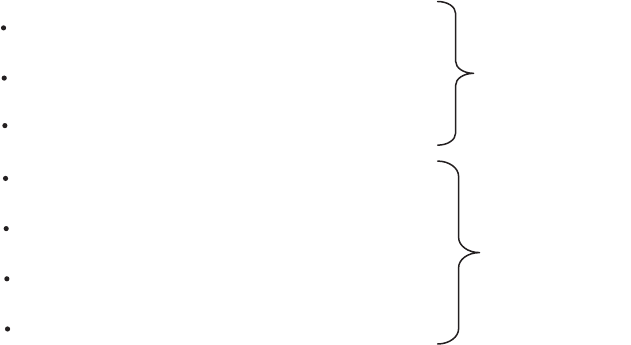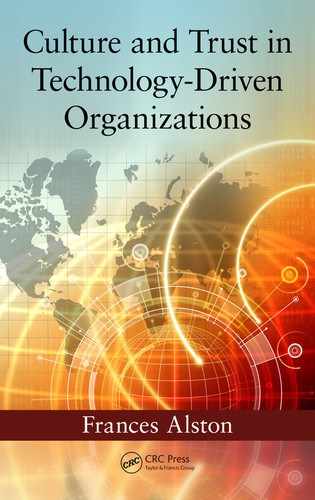67
chapter six
Technology-driven
organization cultures
6.1 Characteristics of technology-driven
organization cultures
It is clear from the study that technology-based organization cultures are
not completely organic or mechanistic in nature. Therefore, any attempt
to dene these cultures in past traditional terms is misleading to say the
least. In order to compete successfully, technology-driven companies
must pay attention to the prevailing culture. When culture is neglected or
ignored, the company is sure to experience some type of negative impact
such as reduced productivity. A quick summary of the literature review
and the survey results indicate the following:
• Trusting culture is important to organization growth.
• The culture of an organization directly affects the level of trust
found in the organization.
• Productivity is affected by trust.
• Technology-driven organization cultures are not purely organic
or mechanistic.
Based on the study and the result of the literature, in purely mecha-
nistic cultures one would expect that an organization would exhibit low
trust; conversely in purely organic cultures the level of trust would be
expected to be considerably higher. Considering the result of the study,
it seems appropriate to ascertain that technology-driven organizational
cultures are not completely organic or mechanistic. Cultures that per-
mit exibility, creativity, critical thinking, and the appropriate level of
risk taking are viewed as optimal for technology-driven organizations.
Also, noted among the organizations that participated in the study, each
organization exhibited various characteristics or elements of organic and
mechanistic culture. This information suggests that technical organi-
zations function primarily in cultures that contain the right balance of
attributes permitting critical thinking and exibility and the right balance
of elements supporting the appropriate levels of rules and procedures
thatserve as a stable guiding force for the organization.

68 Culture and trust in technology-driven organizations
6.2 Redening cultures for technology-
driven organizations
It is reasonable to derive that based on the result obtained from the anal-
ysis of the organization data, technology-based organization cultures
cannot be classied as purely mechanistic or organic. Therefore, cultures
for these organizations are being classied as composite cultures. A com-
posite culture is being dened as a culture that contains the appropriate
level and balance of organic and mechanistic elements and characteristics
needed to meet the goals and objectives of the organization. The primary
attributes of a composite culture are listed below. For the most part, char-
acteristics of both organic and mechanistic cultures in varying levels were
present in the organizations that participated in the study at the time of
data collection.
Composite Culture Attributes
Highly specialized tasks
Work governed by procedures and directions from supervisor
Mechanistic-like
characteristics
Decisions made at the top of the organization
e leader makes maximum use of teamwork
Worker participate in decision making
Organic-like
characteristics
Communication flows in all decisions
Continuous adjustm
ent of tasks as needed
The organizations that participated in the study culture scores ranged
from 3.52 to 5.50. The culture result for each organization is shown in
Table6.1.
The culture data obtained from the study formed the basis for the
composite culture theory as shown in Figure 6.1, illustrating where a
composite culture will fall on the culture continuum.
(M) = A composite culture consisting of more mechanistic characteris-
tics than organic characteristics.
(O) = A composite culture consisting of more organic characteristics
than mechanistic characteristics.

69Chapter six: Technology-driven organization cultures
Mechanistic characteristics such as having an abundance of proce-
dures and rigid processes in place are necessary in some cases to ensure
consistency in operation, product development, and implementation of
new processes or programs. Each of the companies that participated in the
study found it necessary to have strict control in some areas of theoper-
ation to protect the quality of the products and services they provide.
Procedures and policies were used to document the practices and the
policies that were important to the business to protect the quality of their
business line. The companies that participated in the study have been in
business for decades and appear to be quite protable and successful.
The cultures for these organizations fell between the organic and
mechanistic regions on the culture continuum. This relationship is shown
in Figure6.2. Observation of the continuum shows that the cultural attri-
butes of the organization were closer to the mechanistic range in most
cases, with some of the organizations having cultures more toward the
organic region.
Because we now know that trust levels found within an organization
depend directly upon the culture operating within that organization, we
1
2345678
Mechanistic
(M) Composite
(O)Organic
Figure 6.1 Culture continuum.
Table6.1 Culture Means by Organization Data
Organization Culture mean
G 3.52
A 3.90
D 4.32
J 4.19
B 4.50
F 4.90
C 5.00
L 5.07
M 5.18
K 5.17
H 5.30
E 5.47
I 5.50

70 Culture and trust in technology-driven organizations
can begin to focus on the type of culture that is optimal for organization
growth. The key is designing an organization in a manner to ensure that
the appropriate organic and mechanistic characteristics are present and
serve the foundation on which the organization functions.
6.3 Culture—the foundation of trust
Human performance in organizations is greatly dependent upon cul-
ture. Leaders are instrumental in shaping the culture of an organization.
Culture strongly inuences the desire to excel or take a passive posture.
Some cultures encourage members to be creative and productive whereas
others inhibit creativity and productivity. Leaders have the ability to affect
their group’s culture in such a way that productivity and creativity can
be enhanced. Culture is a powerful force that directs the life of its mem-
bers as individuals and in their relationships with others in the organiza-
tion. Values supported by culture can form a bond between people more
effectively than do formal organizational charts, mission statements, or
procedures. A trusting culture facilitates a learning culture, one where
people are not afraid to take risks that are believed to be benecial to
the organization. Culture is the foundation on which trust can develop.
Equipped with this knowledge, there should be a keen interest in gaining
the knowledge and skills necessary to build the foundation so that suc-
cess can be achieved repeatedly during transactions. The foundation of an
organization must have the right balance of elements and attributes that
makes it solid and open to trust building.
6.4 Summary
It was established that culture is the foundation for trust to be developed
and sustained. Relationship building is also a facilitator of building trust.
Oftentimes, the ability or willingness to trust is based on the caliber of
the relationship between parties. A trusting environment allows employ-
ees to feel empowered to take the appropriate level of risk to be creative
and solve problems without the fear of failure. In an environment where
people feel free to trust they are more willing to embrace change. A trust-
ing culture also sets the stage for increased productivity. This relationship
is shown in the trust paradigm in Figure6.3.
Mechanistic Composite Organic
1
2345678
G, A
J, D,
B, F
C, L,
M,
K, H,
E, I
Figure 6.2 Culture continuum—organization placement.

71Chapter six: Technology-driven organization cultures
The trust paradigm represents an important relationship for manage-
ment to be aware of and build on when seeking to create an empowered
environment for workers to excel in their daily work tasks. When people
trust they feel free to open themselves up to new ideas and new ways of
doing things.
Increased
productivity
Job
Satisfaction
Trust
Expedite
change
Culture
Relationship
Figure 6.3 The trust paradigm.
..................Content has been hidden....................
You can't read the all page of ebook, please click here login for view all page.
